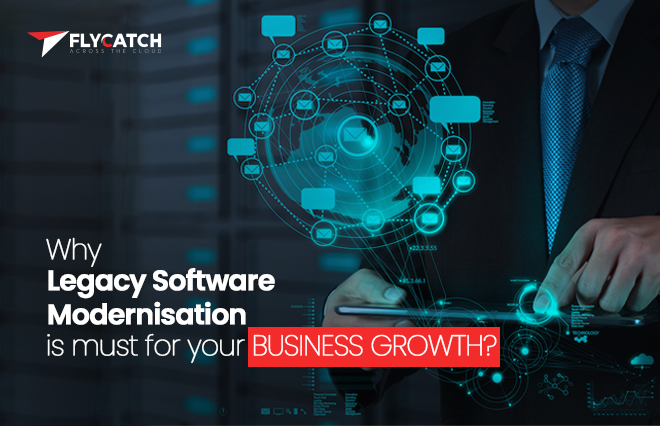Being in a period where digitalization is in its full swing, for business to be competing enough, they should utilize technology in all areas of business ranging from planning, designing, modeling, production, operations, administrations, delivering to resource management. ‘Process Efficiency’ is a critical criteria for defining success. For attaining this, technological backing is crucial.
Legacy Systems that are built on outdated infrastructure, which relies on old technology platforms or softwares are no longer supported or efficient, and are a threat to business growth, as it slows down the process optimization initiatives with high security and privacy vulnerabilities. The high maintenance challenges and rigid nature of these systems make it extremely hard to be redefined or integrated to modern systems. Emphasizing the importance of keeping up with the evolving market trends which demand high operational efficiency and innovation, modernization of legacy systems are inevitable.
Limitations of Legacy System: The problem
- Lack Of Flexibility:
With drastically changing market trends and business requirements, enterprises look for solutions that offer a high range of innovation and adaptability. Legacy systems, built long before this phase of digital revolution, is not equipped or architected on this philosophy.
- Limited scalability:
Engineered from solutioning perspectives that solved yesterday's problem or at most today's problem, the legacy system failed to address future requirements. It may be due to the technical constraints or limitations encountered at that period. Scalability for legacy systems is almost impossible at many instances due to its technological, infractures and business challenges.
- Higher Cost of Maintenances:
The physical and digital environment maintenance cost is another red flag for legacy systems. Built on outdated technology, the resource availability in the market will be too narrow and the skill match with the system requirements may be challenging. It may get even worse when it requires a wide range of physical environment maintenance as well.
The old versions or frameworks may fail to deliver the internet that it was built for when plugged in with new frameworks which again calls for fixation.
- Security Concerns:
With security being least concern at the time of then system planning, the legacy softwares are vulnerable to security threats. Unsupported systems, lack of patches increases the cyber attack possibilities bleeds the business in reliability. Based on the domain, like healthcare or finance, the business existence can be questioned if the system failed to deliver privacy and security compliances.
Modernization: The solution
Modernizing legacy systems is not just about upgrading technology but redefining the way a business operates. It's about aligning systems with the needs of today’s fast-paced and customer-driven market, while also preparing for the future trends.
What does modernization offer?
- Increased Agility and Flexibility
Modern systems are built with flexibility at their core, allowing businesses to quickly adapt to changing market trends and business requirements. On-premises to cloud migration or microservice architecture adoption make the system simple, scalable and flexible bypassing the requirement for costly hardwares, complex infrastructures and dependent workflows.
- Enhanced Security and Compliance
As cyberattacks are more usual, security risks can be mitigated through modernization. Legacy systems often lack up-to-date security protocols, making them vulnerable to breaches and attacks. Modernized systems provide built-in security measures like automatic security updates and patches and ensure industry specific regulation like HIPAA or PCI DSS that protect against evolving threats.
- Operational Efficiency and Cost Reduction
Modern software allows businesses to automate workflows and eliminate manual interventions that are time-consuming and less efficient. By leveraging advanced technologies such as artificial intelligence (AI) and machine learning (ML), companies can drive more intelligent decision-making, resource optimization, and reduce operational costs. Cloud migration is yet another path for cost reduction that offers ondemand infra space required for smooth application performance.
- Improved Customer Experience
Customer expectations are evolving rapidly, with demands for real-time, personalized experiences. Modern systems allow businesses to deliver these experiences by integrating data analytics, AI-driven insights which can transform customer engagement.
How to modernize? : The execution
Considering different factors like the scope of legacy system, business requirement and risks, modernization strategies can be defined:
- Migration to a new platform
This approach involves migrating legacy systems to a modern platform, such as moving from on-premises infrastructure to cloud environments like AWS or Azure. Replatforming retains the core functionality of the system but moves it to a new, more efficient operational platform. This may involve a huge set up cost.
- Code Refactoring
Refactoring involves rewriting or reorganizing parts of the legacy system to improve performance and maintainability while retaining the overall functionality. This strategy allows businesses to retain their original investment in the software while ensuring it aligns with modern architectures.
- Replacing
In some cases, the best option is to completely replace the legacy system with a new solution built from scratch. This is particularly relevant for businesses looking to adapt cloud-native solutions, microservices, AI and IoT.
- Phased Modernization
A gradual approach allows businesses to modernize in phases, prioritizing the most critical areas with respect to the work flows. This reduces disruption and allows companies to test modernized systems in specific areas before fully committing.
Conclusion
Businesses looking forward to digitalization at any level, should do a thorough analysis on current system gaps with process and market requirements. It will give a decent insight on the road blocks the legacy systems offer and the opportunities the modern systems grabbed.Looking forward for modernization, it is advisable to take services of best app development companies which offer top digital transformation services, which will make the process more simpler and effective.





